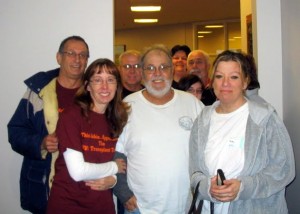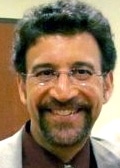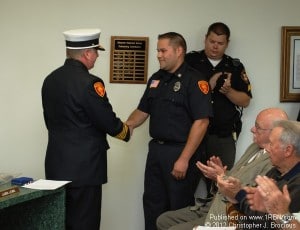by California Casualty | Nominate a Hero, Nurses |
Nurses save lives every single day. But here’s the thing about Nurses: They’ll tell you they’re just doing their jobs. Saving a patient in the ICU? Diligently nursing a premature baby to health? Brightening patients’ lives in nursing homes every single day? All in a day’s work. But when you ask them to describe their jobs, the stories start to come out. Nurses going above and beyond for their patients, working back-breaking hours to make a difference, juggling their own personal lives while still offering life-changing bedside care. These are the stories we wanted to hear. But most of the time, nurses are too humble to tell their own stories. So we started asking Nurses about their Nursing coworkers- their heroes. We were blown away by the responses.
Here are just a few of the Nursing heroes that we have spotlighted thus far in our Nominate a Hero program:
April Nurse Hero
Name: September S.
Profession: Registered Nurse
Nominated by: Johnnie S.
September is a registered nurse raising three children while her husband is deployed in Afghanistan. As her husband puts it, “If superwoman did exist on this planet, her alter ego is September.” Watch the video below to hear directly from him, in a video filmed while serving in Afghanistan, what makes this Nurse such a hero:
February Nurse Hero
Name: Jody W.
Profession: Registered Nurse (Home Health Nurse)
Nominated by: Stephen N.
In December 2011, Jody W. saved a complete stranger’s life. As a Nurse, this wasn’t really something new; saving lives is in the job description. But this time was different; this time Jody saved a man’s life by giving him her kidney. Growing up, Jody saw the struggle of kidney disease and the life-saving power of organ donation first hand. Her close family members battled kidney disease, and several were given a new lease on life through organ donations. In July 2011, Jody put herself on a donation transplant list as a non-directed donor. Not even 5 months later, she was cleared to donate and matched with a recipient. In December, moments before her surgery, Jody got to meet the recipient of her kidney and his family. He is now doing well and on December 8th, 2012, Jody and the recipient celebrated their 1-year transplant anniversary! Jody is also very dedicated to international health and has been on 13 mission trips in Central America. She says she plans to use any prize money from Nominate a Hero on her next trip to Honduras!

Jody, the recipient of her kidney, and their families on the day of the operation.

Jody and the recipient looking GREAT 6-months post-surgery!
December Nurse Hero
Name: Scott D.
Profession: Registered Nurse
Nominated by: Barbara S.
Described as an inspiration to all who know him, Scott is a Registered Nurse working as a home visitor with a hospice unit. Before going into nursing, Scott saved lives as a combat engineer & infantryman with the US Army, jump master, parachute trainer, rescue scuba diver and former Fire Chief. Scott also frequently volunteers to work with the homeless, buying them food and helping them find services and resources. He has also worked with the Veterans Association, attending military funerals and visiting homebound veterans. In his role as a hospice nurse, Scott often brings his beloved dogs with him on home visits. He even volunteered to adopt a veteran’s dog when the owner moved into an assisted living facility. Scott’s nominator, Barbara, describes him as ‘a true hero to his neighbors and friends’ who ‘has been there to help when no one else stepped up.’

Scott D. and his nominator, Barbara
by California Casualty | Nurses |
This Guest Blog post is by blogger Keith Carlson, RN, BSN. Nurse Keith, the blogger behind Digital Doorway, is the featured article in our Nurses’ News Resource: Nursing Pulse. To sign up to receive the Nursing Pulse in your inbox once a month, click here!
____________
Self-Renewal for Nurses: A Guest blog by blogger Keith Carlson
Spring is a time of year often associated with the theme of renewal in many cultures. Easter, Passover, Lent, Daylight Savings, the Equinox and other special cultural moments mark the increase in daylight, the flowering of the earth after the long, cold winter, as well as the general notions of rebirth and resurrection.
In the lives of most nurses, not much changes when winter turns to spring. For some, perhaps the commute becomes less icy and the snow gives way to grass (or mud!), but nothing much changes at the hospital, clinic or agency.
If a nurse is involved in home care, visits to patients’ homes may take on a different feeling as fireplaces become dormant and flowers begin to bloom, and these itinerant nurses may notice significantly less dangerous driving conditions as they shuttle between visits.
Outward signs in nature aside, the changes are actually few as winter turns to spring, so the nurse must find his or her own way of manifesting self-renewal at a time of year when change is in the air.
Physical Renewal
We all know the syndrome. Many of us gain weight over the course of the winter. In fact, some scientists hypothesize that human bodies naturally store fat in the winter based on ancient physiological adaptations in response to the potential for famine. So, as the weather warms, we put on our running shoes, grease up our bicycle chains, and otherwise reactivate our exercise routines.
Exercise is, of course, a great way to “wake up” your body, burn off some of that winter fat, and enjoy the outdoors.
Setting realistic goals for exercise is key to remaining optimistic and empowered in our exercise routines, so make sure you choose goals that are measurable, attainable and realistic. For instance, resolving to walk ninety minutes every day might be setting yourself up for disappointment and self-recrimination, but a goal of walking twenty minutes five days per week might be more attainable.
Food is another place where we can renew ourselves in the spring, especially as fresh, local produce becomes more available. At this time of year, we can make a conscious choice to “lighten up” our diets with more fresh fruits and vegetables, decreasing the intake of carbohydrates that we naturally crave during the colder months. Along with increased exercise, dietary changes help to increase our potential for weight loss, muscle strengthening and improved fitness.
Emotional, Psychological and Social Renewal
Emerging from the relative hibernation of winter, spring can make us feel like we’re bursting at the seams. Friends come out of hiding, we begin to feel a general sense of optimism, and we can feel drawn to come out of our wintry shells and embrace the world.
In Oriental Medicine, the winds of spring are often associated with the liver and the expression of anger, so some people can find early spring challenging on an emotional level.
In Southern France, a spring wind called “Le Mistral” is said to drive people mad, and those of us who live in the desert Southwest of the United States can also feel irritable as the spring winds blow the dusty soil and raise the risk of wildfires.
Meeting with friends, seeking short-term support from a therapist, coach or counselor, or requesting the counsel of a trusted member of the clergy can be helpful in times of transition. Engaging in a therapeutic relationship—whether brief or longer term–can sometimes be just the thing to move forward and galvanize personal growth.
Spiritual Renewal
I mentioned the counsel of a trusted member of the clergy in the previous section, and this can, of course, be one aspect of spiritual renewal.
For those of various faiths, spring brings renewal in the form of Easter’s celebration of the Resurrection, Passover’s acknowledgement of the Jews’ escape from imprisonment in Egypt, and “Al Hijra,” the Muslim New Year’s Day in April that celebrates Mohammed’s migration from Mecca to Medina. Pagan holidays and celebrations also abound in springtime.
Spiritual renewal can also be quite personal and non-denominational. Personally, increased time in nature brings me a sense of renewal and reconnection, with the budding of trees and the return of migratory birds signaling rebirth, change and promise.
Professional Renewal
Apart from the spiritual, physical, psychological and emotional aspects, we can also take a moment to reflect on the notion of professional renewal.
Whatever the season of the year, we’re always free to take stock of our careers, examine our goals, weigh our options, and decide if we’re still heading in a direction that feels growthful and satisfying.
Is your job indeed satisfying? Are you treated like a valuable asset or an expendable cog in a corporate wheel? Does your job feel more mechanical and routine than it used to? Are there professional skills you want to develop? Are there new opportunities to explore?
Questions such as these can spur an inward and outward examination of your career and professional life. Sometimes we can do this on our own, and at other times, a coach, therapist or trusted friend or colleague can assist us in sorting out the professional wheat from the chaff.
You might even decide that, every spring, you’ll take the time to polish up your resume, update your Linked In and social media profiles, and otherwise till the soil of your professional garden so that the ground is ready for the planting of new seeds of opportunity and change.
Spring Forward….and Carpe Diem
Truthfully, spring doesn’t really have to hold any meaning for you at all. In fact, the notion of spring’s renewal may just seem like an artificial construct to you.
Maybe spring is when your allergies are activated and you hole up in your bedroom with the air purifier on full blast as you escape the massive clouds of pollens that fill the air.
Or maybe spring is when you’re busy with your taxes and the last thing you want to do is examine your career or your spiritual standing.
You can find self-renewal at any time of year, and you can choose to seek support or enter a period of self-examination whether there’s snow on the ground or a lawn mower buzzing outside your window.
Self-renewal can occur as discrete events or as ongoing processes. Coaching, psychotherapy and other avenues of exploration are available year-round, but if the energy of spring speaks to you as a time for deeper introspection and personal action, you can certainly seize the day and delve as deeply as you like.
Remember that your life is your own, and the paths you choose to take are personal decisions. Nursing is a career that can bring much promise and professional satisfaction, as well as the possibility of disenchantment and disillusionment. Remain realistic about the course of your life, both personally and professionally, and use the tools and recruit the help that can help you navigate the hard times while celebrating the good.
We each have the opportunity to renew ourselves each day as we awaken from sleep and our feet hit the floor. How will you renew yourself today?
____________________________________________
 Keith Carlson, or Nurse Keith as he’s known to his blog community, has been in the nursing field since 1996. Keith runs a Nursing Blog called Digital Doorway. A Registered Nurse and Certified Professional Coach, Keith says he has equal passion for both, which he uses “to help nurses live the most healthy, balanced and satisfying lives possible.” When Keith isn’t busy nursing, coaching and blogging, he’s working on “RN.FM Radio: Nursing Unleashed.” Keith co-founded the station, which strives to be “a place where nursing thought leaders, entrepreneurs, writers, bloggers and gifted clinicians can make their voices heard.”
Keith Carlson, or Nurse Keith as he’s known to his blog community, has been in the nursing field since 1996. Keith runs a Nursing Blog called Digital Doorway. A Registered Nurse and Certified Professional Coach, Keith says he has equal passion for both, which he uses “to help nurses live the most healthy, balanced and satisfying lives possible.” When Keith isn’t busy nursing, coaching and blogging, he’s working on “RN.FM Radio: Nursing Unleashed.” Keith co-founded the station, which strives to be “a place where nursing thought leaders, entrepreneurs, writers, bloggers and gifted clinicians can make their voices heard.”
To check out Keith’s blog, click here. More information about his coaching can be found here.
To tune in to RN.FM Radio, click here.
To keep up with him on Facebook, click here.
You can find him on Twitter by clicking here!
Check out our Q& A with Nurse Keith, click here.
by California Casualty | Educators, Firefighters, Nominate a Hero, Nurses, Peace Officers |
Click here to cast your vote for February’s Hero of the Month!
Name: Jody W.
Profession: Registered Nurse (Home Health Nurse)
Nominated by: Stephen N.
In December 2011, Jody W. saved a complete stranger’s life. As a Nurse, this wasn’t really something new; saving lives is in the job description. But this time was different; this time Jody saved a man’s life by giving him her kidney. Growing up, Jody saw the struggle of kidney disease and the life-saving power of organ donation first hand. Her close family members battled kidney disease, and several were given a new lease on life through organ donations. In July 2011, Jody put herself on a donation transplant list as a non-directed donor. Not even 5 months later, she was cleared to donate and matched with a recipient. In December, moments before her surgery, Jody got to meet the recipient of her kidney and his family. He is now doing well and on December 8th, 2012, Jody and the recipient celebrated their 1-year transplant anniversary! Jody is also very dedicated to international health and has been on 13 mission trips in Central America. She says she plans to use any prize money from Nominate a Hero on her next trip to Honduras!

Jody, the recipient of her kidney, and their families on the day of the operation.

Jody and the recipient looking GREAT 6-months post-surgery!
Name: Keven R.
Profession: Sheriff’s Deputy
Nominated by: Joel H.
Deputy Keven R. was on patrol in Dallas when he happened to notice something peculiar: a car’s brake lights sticking out of a lake. He immediately drove down to the reservoir, pointed his patrol car’s headlights across the water’s surface and got out of his car. That’s when he realized that the car was slowly sinking- with two young women trapped inside. Deputy Keven R. immediately took off his utility belt and waded into the freezing water. He then swam to the car and shattered the car window’s glass. Inside, the two women were beating on the window, begging for help and telling him that they could not swim. He pulled both women out of the vehicle, ‘bear-hugging’ them as he swam them back to safety. Rowan barely got both women to shore before the car was completely submerged. Amazingly, the entire ordeal was captured on the Deputy’s patrol car dash cam. Check it out below:

Deputy Keven Rowan
Name: Bradley H.
Profession: Volunteer Firefighter & EMT, Full-time EMT
Nominated by: Joyce H.
Brad got his start in firefighting as volunteer at only 18-years-old. Now, he serves as a full-time EMT while still volunteering his time as both an EMT and Firefighter. In March of 2011, Brad was called to a residential fire. When he arrived, there was already heavy smoke coming from the home. Recognizing the urgency of the situation, Brad and his team bravely entered the home–without gear–to rescue a bed-ridden woman trapped on the second floor. Within minutes, Brad and crew had the patient secured in an ambulance and on her way to the hospital. For his heroic action and quick-thinking, Brad was awarded the Medal of Valor.

Brad H. receiving a Medal of Valor and Lifesaving from his Fire Chief.
Name: Mrs. Ridge
Profession: Educator
Nominated by: Vicky P., Debra P., Ginny B., and Zena B. (Parents of current and previous students)
Parents of Mrs. Ridge’s students simply cannot say enough about the impact this inspiring educator has on their children, both academically and personally. They note her ‘incredible spirit, kindness, generosity and excellence as a teacher and citizen.’ Comparing her teaching abilities to being ‘able to leap tall building in a single bound,’ they shared all the ways her dedication and innovation has inspired their children to develop a love for learning. Mrs. Ridge is known for the family-like atmosphere she fosters in her classroom and unique ability to tailor a lesson plan to a diverse group of students by truly getting to know each of her students. She has also been known to dip into her own pocket to make sure she can give her students the very best despite budget cuts in her school district, even going so far as to provide lunches for students that would otherwise go without and donating used clothes from her own home to her students’ families. This educator is truly viewed as a ‘hero’ and ‘angel’ by her students and their families.

Mrs. Ridge and a former student
by California Casualty | Nurses |
This Guest Blog post is by blogger Keith Carlson, RN, BSN. Nurse Keith, the blogger behind Digital Doorway, is the featured article in our Nurses’ News Resource: Nursing Pulse. To sign up to receive the Nursing Pulse in your inbox once a month, click here!
____________
Nursing Amidst the Holidays: A Guest blog by blogger Keith Carlson
At this time of year, most people feel the added stress and joy of the holiday season, and nurses are certainly no exception in this regard. Beginning with Thanksgiving, the pressures and expectations begin to mount exponentially, and although there’s often a great deal to celebrate and express gratitude for, some of us can feel like we’re pushed to our limits as we navigate the waters (and snows!) of the season.
Diagnosis: Alteration in Holiday Spirit
If you work in a hospital, there are most likely Christmas decorations everywhere, and other holidays—like Hannukah and Kwaanza, may also be recognized and honored.
Meanwhile, your patients may be forlorn and lonely as they spend the holidays in the hospital, and part of your unofficial nursing duties may be adding “Alteration in Holiday Spirit” to their care plan (along with interventions to assuage their suffering and sadness).
If you’re a homecare nurse, you have the honor and responsibility of visiting patients in their own homes. This type of nursing brings with it various challenges at this time of year, including patients who have no family or are too poor or ill to fully enjoy the holiday season.
Nurses employed in nursing homes and long-term care facilities also face the potential sadness and isolation of their patients, and witnessing residents’ sadness and loneliness can be a psychic burden for the sensitive nurse.
What About Your Spirit?
While you strive to lift the spirits of your patients—whether in the hospital, nursing home, or other milieu—there’s someone who should also be on your list of those in need of support: yourself! This time of year can be difficult enough without potentially carrying the burden of your patients’ loss and grief, and making sure you pay enough attention to your own needs is paramount.
In some workplaces, the high energy of the holiday season can feel very uplifting and cheerful, with office parties, gifts, cards and special treats that brighten one’s day and add a special something to the functions that still need to be accomplished.
However, if the demands of your workplace are generally intense, you may experience a variety of emotional reactions to the “cheer” being spread by the seasonal festivities, and these reactions and feelings are altogether normal.
Keeping yourself balanced and functioning at your best during this time of year is important, so recognizing how you feel and what your individual needs are is something worth paying attention to, whether those needs are emotional, physical or spiritual in nature.
Holiday Self Care for the Nurse
If the stress of the holiday season is impacting you at work or at home, there are ways to “dial down” the stressors so that you prevent illness, overwhelm and burnout.
First, you must pay close attention to the basic aspects of your self-care, and while these are universal at any time of year, they are even more important now.
Nutrition
Sweets and treats abound at holiday time, but overindulgence can lead to a suppressed immune system, gastrointestinal disturbances, weight gain, nutritional deficiencies, and feelings of lethargy and brain fog.
There are temptations around every corner at this time of year, and avoiding (or limiting) your intake of cookies, cakes, candy, alcohol and other special foods may help you to feel better, even though it’s hard to resist when they’re right under your nose.
If you have a friend or colleague who also wants to resist temptation, enlist one another as “accountability partners” and find ways to provide mutual support. Bringing alternative healthy treats to work can help, as well as collaborating on methods for avoiding the nutritional pitfalls that feel good in the moment but come back to haunt you later.
Hydration
Staying hydrated is always important for every physiological function you can think of. Regularly filling your belly with good quality water can also suppress your appetite when faced with those delectable but nutritionally poor treats that seem to be on every desk and nurses station throughout December. Skip the coffee, soda and sugary eggnog and choose water instead! Your brain and other organs will thank you.
Rest and Sleep
You may laugh, but getting enough sleep and rest is not just important, it’s crucial. The quality and quantity of your sleep impacts your ability to maintain or lose weight, function at your best, and keep an even emotional keel as the stressors increase. If you find yourself staying up too late and getting up too early (or waking up in the middle of the night to ruminate over your shopping lists , then you have to take action to get your sleep on track—stat!
Exercise
This may seem like a joke to many of us, but getting exercise is important in every season, but it’s probably true that the majority of people slack off on their exercise routines during the winter, especially as the holidays approach.
If, like me, you live in a climate where it begins to get cold in November, your summertime exercise regimen may not translate well in winter. Some of us find ourselves confused and stultified as to what to do to stay fit during the colder months, so getting a handle on this can be very important for your health and ability to resist stress and illness.
Your Emotional Well-Being
I mentioned your spirit earlier in this article, and I want to reiterate again how important it is that you pay attention to your own emotional and spiritual needs during the holiday season.
With the recent tragedy in Newtown, Connecticut, many of us are feeling grateful for the safety of our families and friends. However, the holidays can also bring up our losses, our grief, and the people who we miss and are no longer with us. Pay close heed to how you’re feeling, and reach out for help and support if you need it. Support can come from friends, mental health professionals, clergy, an Employee Assistance Program at work, or family members.
Remember, your mental and spiritual well-being are important, and if you’re feeling balanced and healthy mentally, emotionally and spiritually, it allows you to be a more effective nurse and caregiver.
Have Fun and Give Thanks
Of course, the holidays can be stressful, but they can also be joyous and celebratory. One way to care for yourself is to make sure you have time and energy for fun, for family and friends, and for giving thanks for all of the blessings in your life.
We nurses often think of others before we think of ourselves, but being a martyr doesn’t serve you or the people you care about. A nurse who practices good self-care sets an example for others around her, so be the one to set the example by paying attention to your own needs. It’s like they tell you on any airplane before the pilot takes the plane into the sky: you need to put on your own oxygen mask before you help someone with theirs. The same applies to caring for your own needs at work and at home.
Go ahead: nurture yourself, pamper yourself, and make this holiday season one that’s healthy, vibrant and balanced. You deserve it.
________________________
 Keith Carlson, or Nurse Keith as he’s known to his blog community, has been in the nursing field since 1996. Keith runs a Nursing Blog called Digital Doorway. A Registered Nurse and Certified Professional Coach, Keith says he has equal passion for both, which he uses “to help nurses live the most healthy, balanced and satisfying lives possible.” When Keith isn’t busy nursing, coaching and blogging, he’s working on “RN.FM Radio: Nursing Unleashed.” Keith co-founded the station, which strives to be “a place where nursing thought leaders, entrepreneurs, writers, bloggers and gifted clinicians can make their voices heard.”
Keith Carlson, or Nurse Keith as he’s known to his blog community, has been in the nursing field since 1996. Keith runs a Nursing Blog called Digital Doorway. A Registered Nurse and Certified Professional Coach, Keith says he has equal passion for both, which he uses “to help nurses live the most healthy, balanced and satisfying lives possible.” When Keith isn’t busy nursing, coaching and blogging, he’s working on “RN.FM Radio: Nursing Unleashed.” Keith co-founded the station, which strives to be “a place where nursing thought leaders, entrepreneurs, writers, bloggers and gifted clinicians can make their voices heard.”
To check out Keith’s blog, click here. More information about his coaching can be found here.
To tune in to RN.FM Radio, click here.
To keep up with him on Facebook, click here.
You can find him on Twitter by clicking here!
Check out our Q& A with Nurse Keith, click here.
by California Casualty | Educators |
This Guest Blog post by Huffington Post blogger Nicholas Ferroni is the featured article in our Educators’ News Resource: Teachers Notes. To sign up to receive Teachers Notes in your inbox once a month, click here!
Using Music in the Classroom to Educate, Engage and Promote Understanding | Guest Blog by Nicholas Ferroni
The song “Gone” by ‘N Sync stops me in my tracks and nearly brings me to tears; this is not because it’s a horrible song but because, whenever I hear it, I am reminded of the night my college girlfriend and I broke up for the 15th time. (It was for the best that time.) I’m not sharing this for sympathy, or because I’m still bitter towards her (she’s an amazing person). My point is to share what we all know: We are emotionally connected to music — particularly specific songs. We all have songs that remind us of people, places, events, good times and bad times and that bring back memories that have long been repressed or even forgotten. These songs define our lives and we all have this personal and emotional playlist that I call the “Soundtrack of Our Lives.”
We all have this soundtrack, and the choices of songs are never finalized until we are dead. Music is the one constant to which everyone is attached, and that everyone understands. We may disagree about which musicians are good or bad or which generation’s songs are better (every generation thinks their generation’s music is the best). But we all can agree that, without music, life would be silent and sadder than the saddest Adele song (if that’s even possible). Recently, my dear friend Rachel Nichols (a Columbia University graduate), who is one of the most talented actresses and brilliant people I know, surprised my students at school one day. After they regained consciousness (they were extremely excited), Rachel fielded many questions. One question in particular made me smile, a student asked “How do you mentally and emotionally prepare yourself for your differing roles?” Rachel went on to say that if a scene requires intense emotion, she will think of losing a loved one (like Rachel, the thought of losing my parents chokes me up instantly), and that she has various playlists she has made, consisting of different songs that will generate different emotions and mindsets. This just solidified something of which I was already aware: that she is brilliant as well as a beautiful person. My students have requested that she substitutes for me when I’m absent and a few of my male students want her to replace me entirely (I would too if I were them).
Educators have been using music to effectively educate for as long as there has been music. Many of us were fortunate to have those unconventional and edgy teachers (mine were Mr. Caliguire and Mr. “Weez,” and I can’t thank them enough), who played the iconic protest songs from the anti-war movement of the ’60s and ’70s, and then we analyzed and discussed the lyrics. This was one of my favorite activities and it helped me understand the nation and its differing political views better than any textbook or lecture ever could. This, however, is not the method of using music in the classroom to which I am referring. The method of using music that I will be discussing can be applied to all subject areas and used to engage all learners.
There is a reason why we can remember song lyrics for our entire lives, but we forget the lecture or notes our teachers discussed an hour later. I am not going to get into the psychological reasoning behind memory or mnemonics. I am discussing the aspect of using and creating soundtracks for people, places, events and even themes across nearly every area of study. As a film and TV writer (as well as educator), I have found myself not only focusing on writing scripts with engaging characters, but also trying to find songs that would help create more dramatic effects for specific scenes which would eventually be added to their soundtracks. I wondered: If music is so personal to each of us and everyone listens to some form of music, why can’t I utilize music and songs to engage my students? This would help them understand specific historical topics and, at the same time, help them comprehend and retain that information — every educator’s ultimate goal.
After doing so, the results and responses from my students were overwhelming. In a time when educators and education experts are struggling to find ways to engage all learners and differentiation has become a choice method to most districts, I was able to engage, educate, differentiate and increase understanding and retention by simply using something to which we are all already attached. Before I even begin to use songs in my soundtrack activity, I start the year off by having my students create the soundtracks of their lives. Additionally, each student must then describe why each particular song has a personal and sentimental meaning and has earned a place on the soundtrack of his/her life. This introduces students to our emotional attachment to music but also helps them learn a little about themselves. I, of course, share some of the songs on the soundtrack of my life; I play “Gone” and even “The Scientist” by Coldplay, and explain how these songs would lead me to tears. We all share a good laugh and I humanize myself (which is necessary for a comfortable and effective classroom environment). Then, they understand the purpose of the activity and are prepared to use it in class throughout the year.
Since I am a history teacher, I am going to provide a few examples of how to successfully and effectively use songs and soundtracks in class. First, in order to create any soundtrack, students must know some basic information about the person, place or event for which they will be creating a soundtrack. So, prior to the activity, I introduce the basic information surrounding the topic. For example, when we discuss the Reformation, we cover the basic concepts: causes and effects, major figures, events and dates. Once the students have a basic understanding, they then create a soundtrack for the event and have to list 10 songs, with a brief description of why each song would appear on the soundtrack to the Reformation. In the past, they have listed songs such as “In the End” by Linkin Park (which is a great example of the Humanist movement), and “Jesus Walks” by Kanye West (which can relate to the Protestant movement and the questioning of the Catholic church). I am always impressed by my students’ song choices and the variations of songs, artists and genres. The fact that a student can take a song that is completely unrelated to a specific event, and make it relative is a clear example of understanding and long-lasting knowledge. I had a student, who had graduated five years earlier, visit the high school during his college break and the first words out of his mouth were, “Mr. Ferroni, do you know that every time I hear “Move B****” by Ludacris I think of Manifest Destiny, and can recite all the major facts and events of it?” I could only smile in response.
The last example I am going to provide is for an historical figure. For example, let’s say that I ask students to provide a soundtrack or playlist for Christopher Columbus. Students would then list songs that would appear on Christopher Columbus’ iPod playlist (if he had an iPod, of course), and briefly describe why each song would likely be on it. For Columbus’ playlist, you may find everything from “Gold Digger” by Kanye West to “Down with the Sickness” by Disturbed, or even “A Whole New World” by Peabo Bryson and Regina Belle.
As I mentioned, this activity can be extremely effective in many subject areas. An English teacher can have students create a soundtrack for a play or book they are reviewing, or ask students to create a playlist and list songs that would likely be on Macbeth‘s, and even Romeo and Juliet‘s playlist; a creative writing teacher can have students find and discuss lyrics to their favorite songs; an art teacher can have students pick a song and draw or paint an image that they feel best represents the premise and emotion in the song. Finally, a science teacher can have students create soundtracks for specific topics of study, or even songs that would likely be on the playlist of a famous scientist. The options are endless, and even I have yet to scratch the surface of all the ways music and songs can be used in the classroom.
After the students complete their soundtracks (for any given person, place or event), we then create a class soundtrack/playlist. We even take it one step further and select one song to embody the overall theme for the topic of study. In a day when activities and education methods get replaced year after year with the “next big thing,” music will remain a constant to which every student (year after year) will form a connection and association, and the only thing that will change are the songs and the artists (and all current musicians and songs are, after all, merely revised versions of older musicians and songs).
In addition to being an incredibly effective tool, it will turn a growing concern into an education aide. In a day when teachers and schools are finding it nearly impossible to regulate and control cell phone use during school, this activity allows students to use their cell phones, scan their playlists and turn what is a distraction and annoyance to many into an effective and useful means of educating. I am no education expert, but I do have a unique ability to find effective ways to engage students and, as the proverb states, “teach the way they learn.” By using music and having students create historical soundtracks and playlists, I have had great success with nearly all of my students regardless of their learning levels.
_________________
 Nicholas Ferroni is a revered educator and historian who mentors his mostly lower-income students with deep personal commitment and care. This former actor turned teacher, writer, and host was recently named one of the 100 most influential people in America for his commitment to education reform as well as developing a “Teach the Truth” campaign to incorporate more minority figures and groups into the high school social studies curriculum. Nick was also named one of Men’s Fitness Magazine’s “25 Fittest Men in the World,” an honor generally reserved for prominent athletes and actors. He has received national attention by numerous educators and doctors for his unique and innovative methodology in successfully reaching contemporary and urban students, and has been featured in various academic and scholarly journals. Nick is currently developing two history show pilots, one of which he will be hosting, and is currently working on his celebrity charity book titled The Awkward Album, which will reveal some of our most beloved celebrities’ awkward and insecure moments during their childhood, and show every child that everyone (including our most beautiful celebrities) goes through awkward and insecure moments in their youth. You can follow Nicholas Ferroni on Twitter @NicholasFerroni.
Nicholas Ferroni is a revered educator and historian who mentors his mostly lower-income students with deep personal commitment and care. This former actor turned teacher, writer, and host was recently named one of the 100 most influential people in America for his commitment to education reform as well as developing a “Teach the Truth” campaign to incorporate more minority figures and groups into the high school social studies curriculum. Nick was also named one of Men’s Fitness Magazine’s “25 Fittest Men in the World,” an honor generally reserved for prominent athletes and actors. He has received national attention by numerous educators and doctors for his unique and innovative methodology in successfully reaching contemporary and urban students, and has been featured in various academic and scholarly journals. Nick is currently developing two history show pilots, one of which he will be hosting, and is currently working on his celebrity charity book titled The Awkward Album, which will reveal some of our most beloved celebrities’ awkward and insecure moments during their childhood, and show every child that everyone (including our most beautiful celebrities) goes through awkward and insecure moments in their youth. You can follow Nicholas Ferroni on Twitter @NicholasFerroni.








